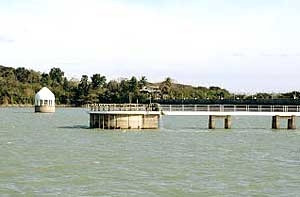Home > Types of Lakes and Ponds > Potable Water
Potable Water
Reservoirs - Ponds Conveyance - Systems

Drinking water reservoirs are a vital component of many populated areas. They are typically designed by damming an existing river in a valley or similar basin. The impoundment floods the basin allowing large amounts of water to be held in reserve for nearby or distant populations. Many different variables can affect the quality of the reserved water as it awaits delivery and ultimate use. Fluctuating water levels, fluctuating water temperatures, stagnation, nutrient influxes from non-point source pollution (i.e. fertilizer or agricultural runoff), as well as other factors can have a negative impact on these waters.
A common natural "contaminant" to these surface water drinking supplies algae. Problems associated with this growth include discoloration, foul odors, unpleasant tastes and clogged filters. Shortened filter runs requiring frequent backwashes reduce the efficiency of water treatment plants, thus raising the cost of water to the consumer. Chlorinating to remove algae is costly, as is carbon filtration to remove off flavors and odors. In addition, there is evidence that the reaction of chlorine with algae can form trihalomethanes (THM's), suspected carcinogens. Treatment for algal control within the reservoir itself is often the most economical and effective means of eliminating these problems.
DISTRIBUTOR




